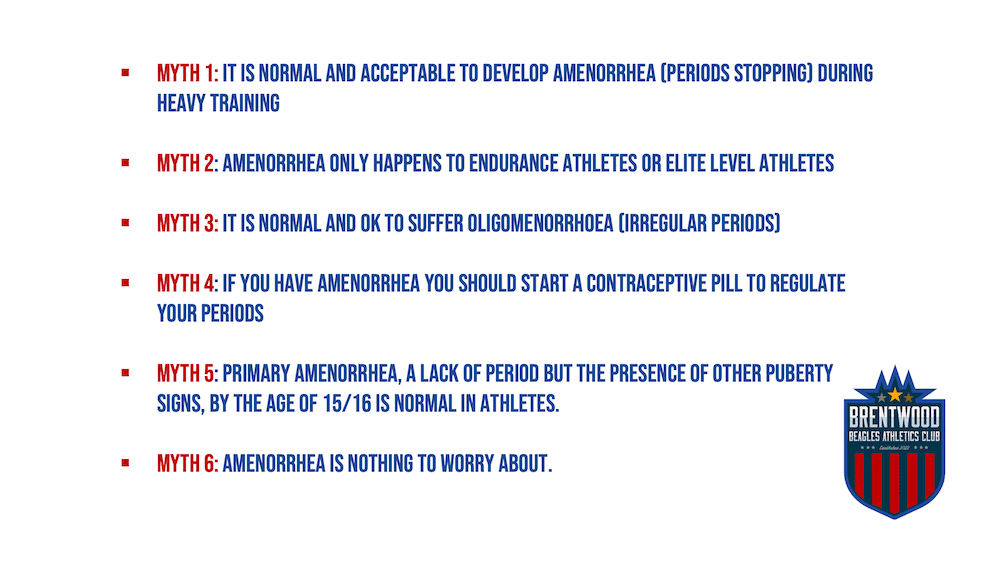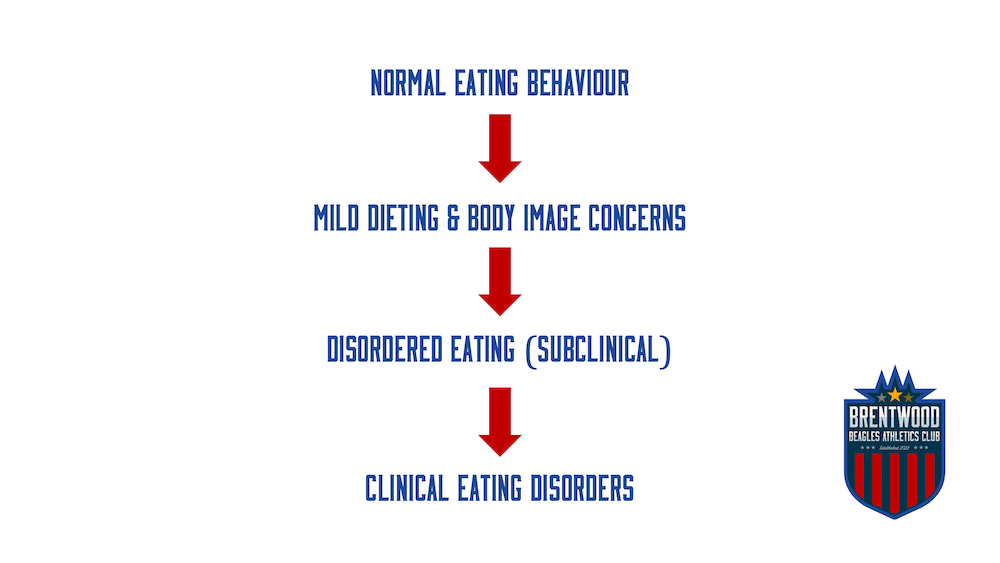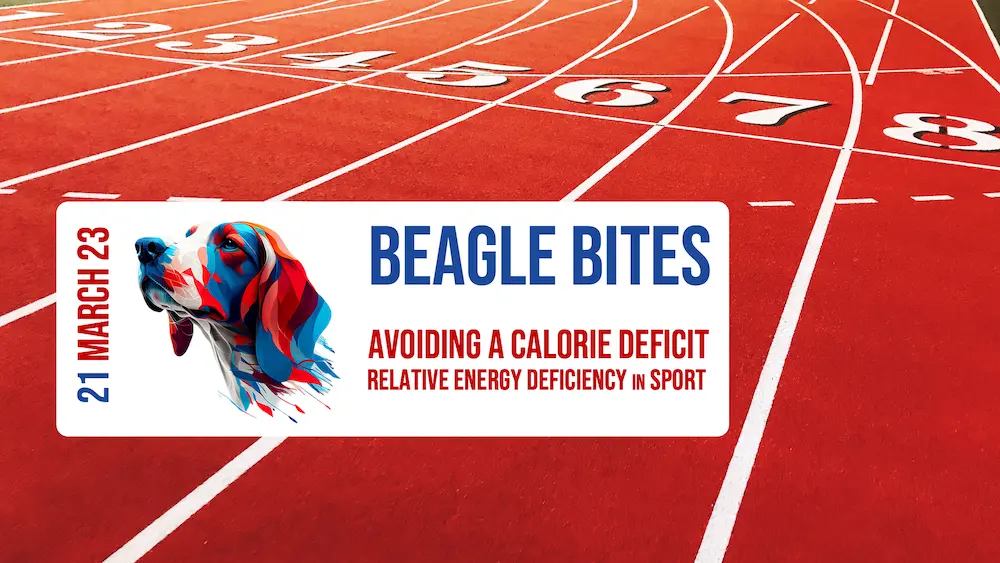This Beagles Bites covers the subject of RED-S, Relative Energy Deficiencies in Sport, a relatively new term but one that is important for athletes of all ages, abilities, and impacting upon on both females and males. Mark as a coach of the Beagles sprint squad, is also Dad of a teenage daughter, and Clinical Lead MSK (Musculoskeletal) Physiotherapist in a large local Foundation trust shares the importance of considering this subject.
RED-s has evolved from The Female Athlete Triad, which has long been established as the interrelationship between energy availability, menstrual function and bone mineral density. This dynamic triad has been used within sports science for more than 25 years. It looked at how the interrelationships between fuel and hormones affected bone health. It is now understood it is has more complexities and variables influencing each of the areas, and it is not limited to affecting females but some of the consequences are recognised in males. In 2014 the International Olympic Committee announced the new term RED-S as part of a consensus statement it published, which it recognised can affect both males and females, elite and non-elite athletes, and that it can lead to irreparable damage, potentially affecting almost every system in the body if left untreated. It is about not fuelling adequately either intentionally or unintentionally. Unfortunately it is something a lot of the medical professions are still unfamiliar with. The British Medical Journal published new guidance for its members in just the past few years, so medical knowledge is slowly improving, though it remains a poorly recognised and understood condition.
What does not fuelling adequately mean?
To repair our bodies, grow and have an efficient immune system to fight off illnesses such as coughs and colds, our bodies need energy. The dietary needs and calory needs of a developing athlete is a greater volume than an adult or non sporty child. More protein, calcium and fat is needed to maintain their health. As a child grows and experiences puberty, the demands for energy increase, school work also places a demand on our energy systems, the demand increasing as the studying becomes more demanding.
When we train or compete the athletes body also needs fuel to create energy for the activity. It uses the same energy sources and calories from the food we eat to enable us to perform in training as repair and grow. If we use up our energy in training and deplete our reserves, we can become ‘energy deficient’, this can have an adverse effect on all our bodily systems and it can affect our performance both on the track, school and work activities and our long term health. To meet the needs of this extra energy requirements means more food.
Whilst sports scientists use the calculation
Energy availability = dietary energy intake (EI) – exercise energy expenditure (EEE)
Or
EA = EI-EEE (measured in Kcal per kg of fat-free mass)
in real terms it breaks down as
A healthy athlete has an energy availability of 45 kcal/kg FFM
A normal resting metabolic rate requires 30 kcal/kg FFM
Low energy availability is classified as below 30kcal/kg FFM
Which looks something like:
A 60kg athlete (FFM 51kg, 15% body fat) has a daily dietary intake of 2000 kcal, expending 600kcal through exercise.
EA = (2000 – 600) / 51 = 27.5 kcal/kg FFM
So below the recommended resting metabolic rate. Energy deficiency is occurring.
What should it be, with a little bit of mathematics:
Energy Availability = Energy intake – Exercise Energy expenditure / kg FFM
45 = energy intake – 600/51kg FFM
45 x 51 = energy intake – 600
2295 +600 = energy intake
= 2895 Kcal
So a 45% increase in calories is required in this example.
So, what are the signs and symptoms of RED-S?
Some of the simple signs and symptoms for both females and males can be the ongoing stubborn sniffles, a recurring cold, or the chronic cough that will not go. Frequent niggles and injuries are another early sign of RED-S often showing initially as fatigue beyond the normal tiredness after training.
More specifically for female athletes can be menstruation changes, some of the myths around this within the sporting world include:

Early discussion of menstruation changes is recommended to assess if it might be attributable to insufficient diet or calorie intake. Where menstruation changes occur for more than a couple of months professional medical advice is recommended.
Intentional and unintentional eating disorders:
Both male and female athletes can develop eating disorders intentionally or unintentionally. Anorexia Nervosa, Bulimia Nervosa and Eating Disorders Not Otherwise Specified (EDNOS) can manifest. We sometimes have a presumption of good health with good athletic performance but underlying can be anxiety, low self esteem and body dysmorphia.
This might result in initially mild dieting to try and trim or improve their tone and image. Dieting can result in less fuel for the body, leading to a worsening performance, the athlete then further diets attributing the poor performance to being too heavy.
Disordered eating to eating disorders: A continuum

It is recognised in research that Athletes are at a significantly increased risk for eating disorders, 47% of athletes competing in lean or endurance sports, 20% female (8% male) elite athletes meet the criteria for a clinical eating disorder.
Longer term risks of RED-S can include implications for fertility and low bone mineral density with increased risk of fractures, Osteopenia and Osteoporosis. 90% of peak bone mass is achieved by the age of 18 in females, adolescence is a crucial period for building bone density for life. Early intervention with the right advice is important.
As an athlete nutrition is essential to help prevent RED-S occurring. Bring some food to training or competitions, so you can refuel immediately after the session or event is an easy self-help action. If you are increasing your training or going through puberty think about increasing your food intake, or f you experience recurrent illnesses or injuries or your menstruation cycle is affected speak to your coach, we can help steer you in the right direction.
As a parent or guardian you can help your child by looking out for the signs and symptoms, the eating habits of your athlete and encourage discussions in the home around these factors. Coaches only see your children for a relatively short time in their weeks activities, looking out for these things and flagging to the coaches early will help us help the athlete as part of the Beagles family.
References
- Haase A.M., Prapavessis H.R.G., Owens R.G. (2001) Pefectionnism, social physique anxiety and disordered eating: a comparison of male and female elite athletes. Psychology Sport Exercise 33, 209-222
- Miller SM, Kukuljan S, Turner AI, et al. Energy deficiency, menstrual disturbances, and low bone mass: what do exercising Australian women know about the female athlete triad? Int J Sport Nutr Exerc Metab 2012;22:131–8. doi:10.1123/ijsnem.22.2.131
- Mountjoy M, Sundgot-Borgen J, Burke L, et alThe IOC consensus statement: beyond the Female Athlete Triad – relative energy deficiency in sport (RED-S). Br J Sports Med 2014;48:491–7. doi:10.1136/bjsports-2014-093502
- Sundgot-Borgen J, Torstveit M K, Prevalence of eating disorders in elite athletes is higher than in the general population Clin J Sport Med. 2004 Jan;14(1):25-32.doi: 10.1097/00042752-200401000-00005
- Relative energy deficiency in sport (RED-S): recognition and next steps Posted on April 22, 2019 by BMJ
- https://www.runnersworld.com/uk/health/a33589189/red-s-relative-energy-deficiency-running/



